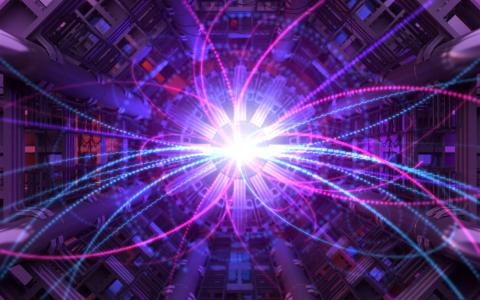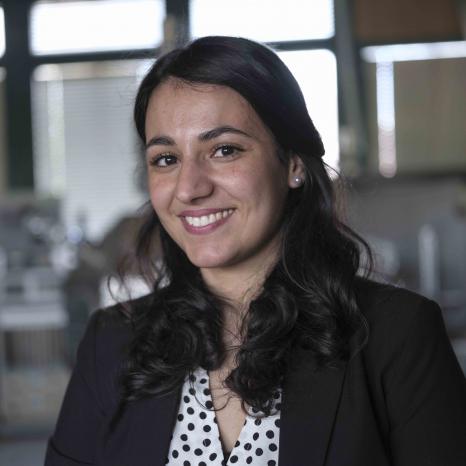
Suheyla Bilgen: the first experimental measurement of stray ions in the LHC
Suheyla Bilgen is a research engineer at the Laboratory of the Physics of the two infinities - Irène Joliot Curie (IJCLab - Univ. Paris-Saclay, CNRS, Univ. Paris Cité). Specialising in dynamic vacuum measurement and materials physics for particle accelerators, she has already contributed considerably to the development of knowledge in her field, even though she is still at the beginning of her career.
After her scientific baccalaureate, Suheyla Bilgen began studying Physics at Paris-Sud University (now Université Paris-Saclay) in 2010. She then completed her international Master's degree in Nuclear Energy, at the National Institute for Nuclear Science and Technology (INSTN), and followed the course entitled Nuclear Reactor Physics Engineering, which dealt with the physics of nuclear reactor cores. In 2014, she completed an internship at the Center for Nuclear Sciences and Material Sciences (CSNSM, one of the five laboratories merged in January 2020 to form IJCLab). She studied the ageing of certain materials used in nuclear power plants by characterising their structural and microstructural changes. On this occasion, she discovered particle accelerators and decided to reorient her field of study towards the optimisation of their operation.
In 2015, Suheyla Bilgen was recruited by the Linear Accelerator Laboratory (LAL, another of the five laboratories merged to form today's IJCLab), and in 2016, she began a thesis in the Particle Physics and High Energy Physics cluster. This involved the study of the dynamic vacuum for particle accelerators via experimental measurements and simulations for the Large Hadron Collider (LHC), the most powerful accelerator in the world. It is located at the European Organization for Nuclear Research (CERN) in Geneva (Switzerland).
Colliding particles
The principle of the accelerator is to create collisions of particles by accelerating them, which generates recombinations and the appearance of new elements, which are identified with the help of detectors located on the LHC ring. The circumference of this structure measures 27 kilometres. CERN is thus helping to discover unknown constituents in the Universe. Suheyla Bilgen is particularly interested in the vacuum in which the particle beams are sent and then accelerated in the collider. "There is no such thing as an absolute vacuum, but the study and processing of the materials that make up the accelerator make it possible to achieve very low vacuum levels, down to 10-11 millibars," says the research engineer.
Secondary particle phenomena: the dynamic vacuum
To collide particles at the desired energy, the accelerated beam should be as thin and dense as possible, and adopt a specific trajectory. "This brightness criterion is essential for measuring sought-after events." But this is sometimes hindered by the creation of secondary particles, a phenomenon typical of accelerators using beams of charged particles. This phenomenon occurs during the desorption mechanism, where neutral residual gas, resulting from interactions of persistent molecules with the accelerator wall material, is ionised by the electromagnetic field of the beam. "This results in the production of stray ions and electrons that travel through the accelerator volume." This also happens during the avalanche phenomenon: "When the electrons interact with the wall of the accelerator, they generate two or three new electrons each time, which are themselves accelerated by the magnetic field and hit the wall again, etc." This electron cloud interferes with the control of the beam characteristics, which reduces the performance of the accelerator. Finally, secondary particles are generated by the synchrotron radiation of the particles, i.e. when they produce photons due to their trajectory, and these photons also interact with the walls of the accelerator to create photoelectrons. All these phenomena characterise what is known as the dynamic vacuum.
Experimental measurement of stray ions and simulation code
Suheyla Bilgen's thesis work focused on two main areas: experimental measurements and the development of a simulation code. In particular, she was the first person to carry out experimental measurements of stray ions produced when the beam circulates inside the LHC. "Thanks to these measurements, I realised that the importance of ions on the wall had been downplayed until now. Although fewer in number, they have a greater impact than electrons on the proper functioning of the accelerator."
She is also at the origin of the conceptualisation and development of DYnamic VACuum Simulation (DYVACS), a code to simulate the dynamic vacuum of a particle accelerator, which takes into account its characteristics (size, materials) and those of the particle beam (type of beam, energy, temporal structure, etc.). Since DYVACS requires a large amount of input data, Suheyla Bilgen reproduces in the laboratory the phenomena of the production of all secondary particles and simulated desorption by electrons and ions that take place in the LHC. She applies this code to tests with different wall cladding materials when modified by irradiation to address secondary particle phenomena. "We test different types of materials, such as copper, carbon and NEG (an alloy of titanium, zirconium and vanadium), and study their response according to, for example, their roughness." Some materials have the property, when activated, of pumping out stray molecules, which lowers the pressure inside the accelerator.
Promising results with ambitious prospects
This unpublished work won several awards. In 2019, Suheyla Bilgen was awarded the best poster prize by the French Physics Society (SFP) during the Accelerator conference. In 2020, she defended her thesis and won the thesis prize of the Particles, Hadrons, Energy, Nuclei, Instrumentation, Imaging, Cosmos and Simulation (PHENIICS) doctoral school of Université Paris-Saclay. In 2022, the French Academy of Sciences awarded her the Madeleine Lecoq Prize for her research into materials for accelerators.
Since 2020, Suheyla Bilgen has been working within the MAVERICS team (Materials for Accelerators, Dynamic Vacuum and Innovative Research on Superconducting Cavities), reporting to IJCLab. The team studies innovative materials for the dynamic vacuum of accelerators and for superconducting cavities (structures that make beam acceleration possible). "We have just moved into the new Vacuum and Surfaces platform, which includes a wide range of equipment that will enable us to continue our work on characterising the surfaces of materials for accelerators." She is also conducting preliminary studies for the Future Circular Collider (FCC), a 100-kilometre circumference accelerator that aims to push the limits of particle colliders to explore higher energy ranges.
Suheyla Bilgen is also keen to share her knowledge. She teaches crystallography at the École polytechnique, as well as dynamic vacuum and vacuum technologies for particle accelerators as part of the Techniques for the Physics of the Two Infinities university diploma created by the National Institute of Nuclear and Particle Physics (IN2P3) of the French National Centre for Scientific Research (CNRS).

